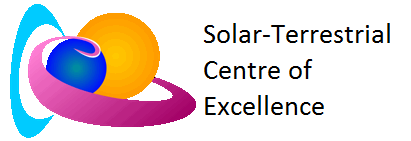Note: all terms listed in alphabetical order, references provided at bottom of this webpage
Aeronomy : an interdisciplinary field of science that deals with the physics and chemistry of the upper atmosphere of the Earth and other planets under the effects of magnetic fields and electromagnetic and corpuscular radiation from space.
Atmosphere : a layer of gases surrounding the Earth and retained by the Earth's gravity. It contains roughly 78% nitrogen, 20.95% oxygen, 0.93% argon, 0.038% carbon dioxide, trace amounts of other gases, and a variable amount (average around 1%) of water vapour. There is no definite boundary between the atmosphere and outer space; it slowly becomes thinner and fades into space. However, three quarters of the atmosphere's mass is within 11 km of the surface. Temperature-oriented nomenclature differentiates the strata of the atmosphere as follows: troposphere, from sea level up to about 10 km, where the temperature decreases; stratosphere, from 10 km up to about 45 km, where the temperature increases; mesosphere, from 45 km up to about 95 km, where the temperature decreases again; thermosphere, from 95 km to about 400 km, where the temperature increases again; and exosphere, above about 400 km, where the temperature is constant.
Geomagnetic storm : a temporary disturbance of the Earth's magnetic field and the magnetosphere region as a whole. The geomagnetic storm is caused by a solar wind shock wave (generated by solar coronal mass ejections or solar flares) which typically strikes the Earth's magnetic field about 24 to 36 hours after such major solar events. The solar wind pressure on the magnetosphere depends on the Sun's activity, and is capable of modifying the electric currents in the ionosphere. Magnetic storms usually last 24 to 48 hours, but some may last much longer.
DOY (Day of Year) : a (short) representation of the ordinal date within a single year, an integer number ranging between 1 (first day of the year, 1 January) and 365 (the last day of a perpetual year, 31 December) or 366 (the last day of a leap year, 31 December). Alternative notation: DDD. An ordinal date is a calendar date typically consisting of a year (YYYY) and a day of year (DDD), starting on 1 January, although year (YYYY) may sometimes be omitted. The two numbers can be formatted as YYYY-DDD to comply with the ISO 8601 ordinal date format. (annex)
GNSS (Global Navigation Satellite System) : a satellite system that is used to pinpoint the geographic location of a user's receiver anywhere in the world., e.g. the US Global Positioning System (GPS), the Russian Federation's Global Orbiting Navigation Satellite System (GLONASS), and the European Navigation System (GALILEO).
Ionogram : an instantaneous record of the ionospheric conditions (above the sounder) indicated by the relationship between the frequency of the radio pulse emitted upwards and the virtual heights of echoes reflected from the ionosphere.
Ionogram scaling : the process of deducing ionospheric characteristics (foF2, foF1, foE, fmin, h'F2, h'F, h'E, etc.) from ionograms. References (Piggott and Rawer, 1972: Manuel URSI pour le dépouillement et l'interprétation des ionnogrammes; Piggott and Rawer, 1978: URSI Handbook of Ionogram Interpretation and Reduction; Wakai et al., 1987: Manual of Ionogram Scaling)
Ionosphere : the inner part of the upper atmosphere, extending from about 50 km to 1000-2000 km altitude, which is being ionised by the solar radiation. The major part of the ionisation is produced by solar X-ray and ultraviolet radiation and by corpuscular radiation from the Sun. In the ionosphere, free electrons occur in sufficient density to have an appreciable influence on the propagation of radio frequency electromagnetic waves. The ionospheric plasma consists of mostly H+ and He+ ions above 1000 km, O+ ions from 300 to 500 km, and molecular ions (N2+, O2+, NO+) below 200 km. Total ion densities (= electron density) range from 10^8 to 10^13 m^-3. The ionosphere plays an important role in radio wave propagation. The modern-day society uses sophisticated technological systems relying on the emission and reception of radio waves: ground-to-ground and ground-to-space telecommunications, Global Navigation Satellite Systems - GNSS (such as GPS, Galileo), radars, etc. A disturbed ionosphere can strongly affect the performance of such technological systems and it is, therefore, important to monitor and model the ionospheric activity and its effects.
Ionospheric storm : the occurrence of turbulent processes in the ionosphere, due to an ongoing geomagnetic storm. The ionospheric storm is characterised by initial increase in the density of ionisation followed by a period of a pronounced decrease.
Magnetosphere : a space region whose shape is determined by the extent of the Earth's internal magnetic field, solar wind plasma, and interplanetary magnetic field. In the magnetosphere, a complex mix of free ions and electrons from both the solar wind and the Earth's ionosphere is confined by magnetic and electric forces that are much stronger than gravity and collisions.
Navigation : the process of planning, recording, and controlling the movement of a craft or vehicle from one place to another. Different navigational techniques have evolved over time but all involve locating one's position compared to known locations or patterns.
Plasmasphere : a region of relatively dense but cool plasma, surrounding the Earth, extending to distances of about 5 Earth radii (RE). It is a torus of cold (~1eV), dense (tens to thousands of particles per cubic centimetre) plasma that occupies roughly the same region of the inner magnetosphere as the ring current and radiation belts (between L=2 and L=7) and that is populated by the outflow of ionospheric plasma along mid- and low-latitude magnetic field lines (i.e. those that map to magnetic latitudes of ~60 degrees and less). The hydrogen ion (H+) is the principal plasmaspheric ion, with singly ionized helium accounting for ~20% of the plasmaspheric plasma.
Skymap: a detailed image of the space above the digisonde. It shows the locations of all points in the ionosphere from which the radio wave is reflected back to the digisonde.
Space Weather : the complex conditions on the Sun, in the solar wind, interplanetary space, magnetosphere, ionosphere, and thermosphere, that can influence the performance and reliability of the space-borne and ground-based technological systems.
Telecommunication : the transmission of signals over a distance for the purpose of communication. This process typically involves the sending of electromagnetic waves by electronic transmitters. Each telecommunication system consists of three basic elements: a transmitter that takes information and converts it to a signal, a transmission medium over which the signal is transmitted, and a receiver that receives the signal and converts it back into usable information.
TEC (Total Electron Content) : the integral value of the electron density along a satellite-to-ground signal raypath. Ground-based GNSS receivers measure the total number of electrons along a path of the radio wave between the GNSS satellite (for GPS at ~20,000 km altitude) and the ground. The ionospheric region contributes to the most of the TEC value. 1 TEC unit is 1016electrons per square metre.
References:
Piggott, W.R., K. Rawer (1972): URSI Manual of Ionogram Interpretation and Reduction (Manuel URSI pour le depouillement at l'interpretation des ionogrammes). Report UAG-23A, Second Edition (November 1972), 181 pages, World Data Center A for Solar-Terrestrial Physics, NOAA, Boulder, CO, USA. (download)
Piggott, W.R., K. Rawer (1978): URSI Manual of Ionogram Interpretation and Reduction. Report UAG-23A, Second Edition (Revised Chapters 1-4, July 1978), 135 pages, World Data Center A for Solar-Terrestrial Physics, NOAA, Boulder, CO, USA. (download)
Wakai, N., H. Ohyama, T. Koizumi (1987): Manual of Ionogram Scaling. Third Edition (October 1987), 119 pages, Radio Research Laboratory, Ministry of Posts and Telecommunications, Japan. (download)

